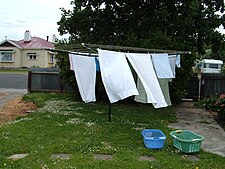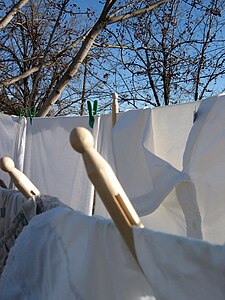Clothes line
From Wikipedia, the free encyclopedia
For other uses, see Clothesline (disambiguation).
A clothes line or washing line is any type of rope, cord, or twine that has been stretched between two points (e.g. two sticks), outside or indoors, above the level of the ground. Clothing that has recently been washed is hung along the line to dry, using clothes pegs or clothes pins. Washing lines are attached either from a post or a wall, and are frequently located in back gardens, or on balconies. Longer washing lines often have props holding up sections in the middle due to the weight of the clothing.More elaborate rotary washing lines save space and are typically retractable and square or triangular in shape, with multiple lines being used (such as the Hills Hoist from Australia). Some can be folded up when not in use (although there is a hazard of getting fingers caught, so there is usually a safety button).
In Scotland, many tenement buildings have a drying green which is a communal area predominantly used for clothes lines - it may also be used as a recreational space.
Contents[hide] |
[edit] Comparison

A rotary, or Hills Hoist, type of clothes line

Sundrying in Hermiston, Oregon.
[edit] Advantages of a clothes line
- Saves money[1][2]
- Zero greenhouse gas emissions per load[1][2][3] (2 kg of greenhouse gas emissions from the average mechanical clothes dryer per load)[3]
- Laundry smells "clothes-line fresh" without using chemicals[4][5][6][7]
- Less fabric wear and tear[2]
- Laundry items do not shrink (hot air from a mechanical clothes dryer may shrink items)
- No static cling
- Laundry items stay softer (mechanical clothes dryers tend to remove short, soft, fine fibers)
- Laundry items may be less wrinkled (items left in a mechanical clothes dryer tend to get wrinkled)
- Laundry items may dry more quickly on dry or windy days (summer or winter)
- No risk of fire (mechanical clothes dryers can potentially catch on fire)
- No risk of toxic fumes (gas-powered mechanical clothes dryers can potentially leak gas)
- Avoids the potential of airborne lint and reduced air quality
- Eliminates heating up the inside of a house by a mechanical clothes dryer
- Eliminates the noise from a mechanical clothes dryer
- Provides a source of exercise and beneficial sunshine
- When drying clothes indoors, evaporating moisture will remove heat from the air which could save on space cooling costs.[8][9]
- More revenue for those who sell or install clothes lines, clothes pins, drying racks, etc.
[edit] Disadvantages of using a clothes line
- Putting laundry on a line usually takes more time than putting it into a mechanical dryer (as laundry items have to be hung up and fixed one by one).
- Laundry items need to be hung indoors during rainy weather, or may get wet if the weather changes.
- Neighbours may find it aesthetically unpleasant[1]
- Risk of theft or vandalism of clothes
- Laundry items may be more stiff (at least initially) - with or without the fabric softener that can be used with a mechanical dryer
- Wind, temperature, and humidity can vary the drying time[10][11][12]. In particular, drying will typically take significantly longer than in a mechanical dryer (except in very warm and dry weather).
- Environmental contaminants such as soil, dust, smoke, pollen and animal droppings can come in contact with clothing.
- Less revenue for those associated with the production and distribution of electricity/gas[1][2]
- Less revenue for those who sell or service mechanical dryers
- When drying clothes indoors, evaporating moisture will remove heat from the air which may require additional space heating to maintain room temperature[8][9] Increased humidity may make people feel warmer, which can be a problem in warm weather, and can increase fungal growth.
[edit] Drying laundry indoors
Laundry may be dried indoors for a variety of reasons including:- inclement weather
- physical disability
- lack of space for a line
- legal restrictions
- to raise the humidity level indoors
- to lower the air temperature indoors
- convenience
- to preserve privacy
The evaporation of the moisture from the clothes will cool the indoor air and increase the humidity level, which may or may not be desirable. In cold or dry weather, increased humidity may make people more comfortable. In warm weather, increased humidity may make people feel even hotter. Increased humidity can also increase growth of fungi, which can cause health problems.
An average-sized wash load will convert approximately 3000 BTU of ambient heat into latent heat stored in the evaporated water. To determine how much heat is being removed by a load of laundry, weigh the clothes when they are wet and then again after they have dried. The difference is the weight of the evaporated water. Multiply that weight in pounds by 1050 get the BTU, or multiply by .3074 to get kilowatt-hours. (Note: If the moisture later condenses inside the house, the heat will again be released back into the room.)[8][9]
[edit] Drying laundry in freezing conditions
Laundry may be dried outdoors when the temperature is well below the freezing point. First, the moisture in the laundry items will freeze and the clothing will become stiff. Then the frost on the clothes will sublimate into the air leaving the items dry. It takes a long time and it is usually much quicker to dry them indoors; however, indoor drying removes heat from the air so it is a trade-off between speed and energy efficiency.[edit] Controversy
A variety of interests are involved in the controversy about clothes lines, including: global warming, individual rights, the economy, private property, class, aesthetics, health, energy, national security and nostalgia.When mechanical dryers were first introduced, only well-to-do families could afford them and they became associated with affluence. However, now that most people can afford a mechanical dryer, clothes lines have become associated with a "home-town" character in neighborhoods because they are indicative of a low-crime area. (Clothes lines are used less frequently in high-crime areas because of the risk of clothes being stolen.) Also, environmental concerns and higher energy prices have created a new generation of clothes line advocates. Still, the old association with poverty persists.
Those against the use of clothes lines include:
- some associated with oil and coal companies
- some associated with electric and gas utilities
- mechanical clothes dryer manufacturers and retailers
- some associated with appliance repair shops
- people who find clothes lines aesthetically displeasing
- older people who still associate mechanical dryers with wealth
- people who prefer to use mechanical driers for personal reasons (speed, more convenience, disability, lack of space, etc.)
- people who believe that clothesline use will reduce reliance on foreign energy for national security reasons
- people who believe that clothesline use will reduce global warming
- people who believe that clothes blowing in the breeze are aesthetically pleasant
- older people who are nostalgic for times when everyone used clothes lines
- people who associate them with low-crime areas
- people who prefer to use clothes lines for personal reasons (save money, get exercise, no static cling, etc.)
As of October 2009, the states of Florida, Colorado, Utah,[14][15][16] Hawaii, Maine and Vermont had passed laws forbidding bans on clothes lines. Similar bills were under consideration in Maryland, North Carolina, Oregon and Virginia. At least eight states restrict homeowners associations from forbidding the installation of solar-energy systems, and lawyers have debated whether or not those laws might apply to clothes lines. A British filmmaker, Steven Lake, planned to release a film in May 2010 titled Drying for Freedom about the clothes-line controversy in the United States.[13]
In Canada, the province of Ontario lifted bans on clothes lines in 2008.[17]
[edit] Images
| Clothes pins (or pegs) on a clothes line | |||
| Clotheslines fiber made with polyurethane |
[edit] See also
- Clotheshorse or drying rack – for drying clothes inside.
- Clothes dryer
- Drying cabinet
- Penman equation
- Project Laundry List, New-Hampshire, US, organisation to encourage outdoor drying
- Sheila Maid
[edit] References
- ^ a b c d e Rosenthal, Elisabeth (April 17), "A Line in the Yard: The Battle Over the Right to Dry Outside", New York Times, http://www.nytimes.com/2008/04/17/world/americas/17clothesline.html?_r=1&scp=3&sq=clothesline&st=nyt&oref=slogin
- ^ a b c d Aun, Leslie M. (August 17), "Nature's Dryer Revisited", Washington Post, http://www.washingtonpost.com/wp-dyn/content/article/2006/08/16/AR2006081600394.html
- ^ a b a clothes dryer and a clothes line, ecofx, January 10, 2008, http://ecofx.org/wiki/index.php?title=clothes_dryer
- ^ Brand, Downy (April 4), Fabric Softener Facts, http://www.downy.com/en_US/articles/fabric_softener_facts.jsp
- ^ P&G, Global Operations (June 17) ([dead link]), http://media.tide.com/en_US/messageboard/readthread.jsp?connectionID=74108
- ^ Products, Landor (April 17), Case History, http://www.landor.com/index.cfm?do=ourwork.casehistory&cn=5233&bhcp=1
- ^ American Sanitary, Supply (September 5), clothesline fresh, http://www.americansanitarysupply.com/index_files/catalog08_files/Page1309.htm
- ^ a b c Diamond, Sheldon R. (1970). Fundamental Concepts of Modern Physics. USA: AMSCO School Publications, Inc. pp. 205. "During evaporation... The surroundings thereby become the ultimate source of the energy required to change the phase of [water] from liquid to gas."
- ^ a b c Enthalpy of vaporization. (2009, March 29). In Wikipedia, The Free Encyclopedia. Retrieved 20:18, April 4, 2009, from http://en.wikipedia.org/w/index.php?title=Enthalpy_of_vaporization&oldid=280526588
- ^ "Second Law of Thermodynamics", Second Law of Thermodynamics
- ^ "Grashof number", Grashof number
- ^ "Clausius-Clapeyron relation", Clausius-Clapeyron relation
- ^ a b Urbina, Ian, "Debate Follows Bills to Remove Bans on Clotheslines", The New York Times, p 23, October 11, 2009
- ^ http://www.realestatejournal.com/homegarden/20070919-chaker.html
- ^ Chaker, Anne Marie, "The Right to Dry", The Wall Street Journal, September 18, 2007
- ^ Colorado Governor's Energy Office HOA Bill - HB 1270
- ^ Ontario premier lifts outdoor-clothesline ban
[edit] External links
| Wikimedia Commons has media related to: Clothes lines |








